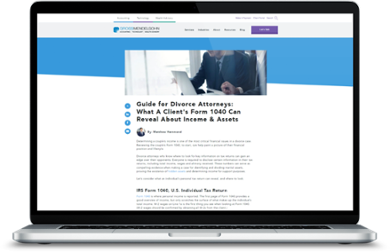Economic damages claimed by individuals in cases arising from personal injury, wrongful death, wrongful employment termination and employment discrimination typically include lost earnings and fringe benefits.
Attorneys frequently retain CPAs as expert witnesses to determine the amount of those economic damages and to provide expert witness testimony. Let’s look at the role of a CPA as an expert in these cases.
The Role of the CPA
The CPA’s role is to objectively calculate the lost earnings and benefits based on an evaluation of the facts and circumstances of the case, developing reasonable assumptions and using a logical approach to presenting the calculations. The expert’s testimony should include explaining and supporting the facts and circumstances, the assumptions applied, and the conclusions and opinions reached.
What Information Does a CPA Use to Calculate Lost Earnings and Benefits?
The expert’s work begins with obtaining an understanding of the facts of the case. This includes gathering information on the incident causing the loss and the individual making the claim. Such information includes the individual’s date of birth, race, gender, educational level, licenses and certifications held, employment information and medical information.
The individual’s employment information is very important in determining their lost earnings and benefits. Employment information to be gathered includes the individual’s pre-loss history of employment and their current employment status, earnings and fringe benefits.
Documents useful in analyzing the individual’s past earnings and benefits include income tax returns, W-2s, recent pay stubs, annual fringe benefit statements and personnel files. If the individual is self-employed, you will need to obtain information on the income, expenses and net profits of the business in order to evaluate their earnings from that business.
Information may also be available in answers to interrogatories and deposition testimony. Consideration should also be given to economic data obtained from external sources that is relevant to the plaintiff’s situation and to reports prepared by others evaluating the plaintiff’s situation such as vocational rehabilitation experts and medical experts.
Projecting “But-for” Earnings and Benefits
Projecting an individual’s “But-for” earnings and benefits (the earnings and benefits that would have been realized absent the loss event) requires an evaluation of the factual information as to what the individual’s earnings and benefits were prior to the loss event and considering information and documentation as to expected changes in post-loss earnings and benefits had no loss occurred.
The plaintiff’s future earning potential may differ from past earnings in certain situations such as recently obtaining an advanced degree or certification that will result in the plaintiff being able to be promoted or qualify for a different position that could increase his or her earnings in the future. Those situations should be documented and not based on a plaintiff’s stated desire or goal to attain higher earnings without evidence of actions taken to accomplish such a goal. The “But-for” earnings and benefits are compared to the post-loss actual and expected future earnings and benefits to calculate the lost earnings and benefits.
Projecting an individual’s lost benefits begins with an analysis of the individual’s actual fringe benefits received from his or her employer prior to the loss. The value of lost fringe benefits may be measured based on the cost of employer provided fringe benefits or the employee’s cost to replace those lost benefits. There are certain fringe benefit costs incurred by employers, such as payment of unemployment insurance contributions, workers compensation premiums and Medicare tax on wages that would not be considered a lost benefit to the employee and therefore should not be included in the value of lost benefits.
Projecting the plaintiff’s lost earnings and benefits will include developing various assumptions such as the growth rate to be used in projecting future earnings and benefits, the plaintiff’s worklife expectancy and the discount rate to be used to compute the present value of future losses. Those assumptions should be reasonable and supported based on analyses specific to the plaintiff and published data available from external sources.
Need Help?
Courts require that damages be calculated to a reasonable degree of certainty and such damages must not be speculative or remote. Therefore, an expert must know the facts specific to the case and the person who has sustained the damages in order to prepare reasonable and reliable calculations of lost earnings and benefits that will be accepted by the court.
Our Forensic, Valuation & Litigation Support Group specializes in economic damage calculations including those related to lost profits, wages and earnings. Contact us online or call 800.899.4623 for help.
This post was originally published in April 2021 and was updated in February 2024.


